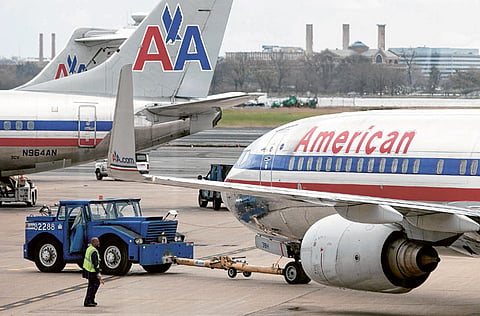COVID-19 downturn: Airlines try to keep their distance from bankruptcy
US Government lends its support with $25b package - how will other governments fare?

New York: The global airline industry has never had it so bad. Not even after the 9/11 terrorist attacks.
Airlines could lose a quarter of a trillion dollars in revenue this year, according to the International Air Transport Association, as travel comes to a standstill with countries locked down to fight the coronavirus. Most carriers will go bankrupt by the end of May if they can’t find support, Sydney-based CAPA Centre for Aviation said last week.
Which airlines are most at risk? Like the virus, the crisis is indiscriminate, affecting everyone from budget operators to national flag carriers. Aircraft manufacturers and their suppliers also are under immense pressure, with Boeing Co. calling for billions of dollars in state support and Airbus SE extending credit lines and canceling its dividend.
Calculating who survives and who doesn’t
Using the Z-score method developed by Edward Altman in the 1960s to predict bankruptcies, Bloomberg News filtered out listed commercial airlines to identify the ones most at risk of going bust. The calculations don’t take into account government bailouts or other funding sources that could help keep operators alive.
While the list is concentrated in Asia, mostly due to high debt levels, European carriers aren’t immune, as the collapse of UK regional airline Flybe Group Plc proved. According to Altman, scores of 1.8 or below indicate a risk of bankruptcy and scores over 3 suggest sound footing. Indebted low-cost carrier Norwegian Air Shuttle ASA and Air France-KLM both landed below the threshold, as did American Airlines Group Inc. and SkyWest Inc.
Governments free up cash
Governments around the world are in talks with aviation companies about financial support, and those with deep-pocketed backers - such as Delta Air Lines Inc. with billionaire investor Warren Buffett - will have access to other avenues for cash.
The Z-score involves five variables measuring liquidity, solvency, profitability, leverage and recent performance. The model initially had accuracy rates of over 95 per cent in predicting bankruptcies, but has come down to between 80-90 per cent based on a year before insolvency, Altman said in a 2018 interview.
Cash in hand means all
A spokesman for Pakistan International Airlines Corp. said losses and debt have become too much for the company to handle alone and that options suggested to the government include a debt-to-equity swap and long-term bond issue.
India’s SpiceJet Ltd. sees “no possibility at all” of failing, has maintained adequate cashflows and expects a surge in demand as the virus is contained, a spokesman said. Virgin Australia Holdings Ltd., which has furloughed 80 per cent of its workforce and slashed flights to a bare minimum, said it is taking measures to rapidly reduce its cost base to preserve cash.
Asiana Airlines Inc. said it secured a bridge loan and will receive 1.6 trillion won ($1.3 billion) from Korea Development Bank and other creditors. It also said financials will improve once HDC Hyundai Development Co. and its partners complete their acquisition of Kumho Industrial Co.’s stake.
Norwegian Air is trying to secure a government lifeline worth up to $270 million under certain conditions, and this week two Nordic banks were approved to provide a guarantee for the required 10 per cent for the first tranche.
Air France-KLM counts the French and Dutch governments as its biggest shareholders, and both governments have signaled they will provide support if needed.
US windfall in aid
US passenger carriers are poised to receive up to $25 billion in payroll support funds and cargo haulers $4 billion - earmarked for items like salaries, benefits and healthcare - with a like amount of loans.
Much hinges on an airline’s ability to use cash in hand or access more money. Some in Asia, including Korean Air, Asiana, China Southern Airlines Co. and China Eastern Airlines Corp. have reserves to last only weeks, according to Bloomberg Intelligence. IndiGo, operated by InterGlobe Aviation Ltd., has enough to last about a year even if its fleet remains grounded (and staff costs drop only 30 per cent.
Different methods of estimating airline viability give out varying results, and not all airlines that are short of cash are going to go bust.
The model used by BI uses publicly available data on cash in hand and operating expenses to reach estimates on monthly cash burn. That method doesn’t take into account undrawn credit facilities or unencumbered aircraft assets, which are often used as a cash buffer. The model assumes 100 per cent capacity cuts and zero cash inflow.
Go to markets or owner
Singapore Airlines Ltd. unveiled a plan to initially raise about S$8.8 billion ($6.2 billion) to contend with the impact of the virus, with state investor Temasek Holdings Pte., the carrier’s biggest shareholder, saying it would back the resolutions.
A Korean Air spokeswoman said the company is about to raise funds through asset-backed securities, reflecting market confidence in the carrier. “We also expect the government to provide support measures,” she said, adding that the airline plans to generate more revenue by increasing cargo operations.
Japan Airlines Co. issued bonds earlier than originally planned based on the trend in interest rates, according to a spokesman.
Access to funds when in need
Airlines could sell assets including planes to raise cash. Without taking that step, assuming revenue from ticket bookings is kept, some may still last more than a year, according to analysts at Credit Suisse Group AG. While the liquidity situation is fluid and doesn’t take into account potential bailouts, this list gives a sense of which airlines are best-positioned if travel is suspended for longer.
Ryanair Holdings Plc said it had cash and equivalents of over 4 billion euros as of March 12, undrawn credit lines and nearly 300 owned aircraft valued at about $8 billion to $10 billion.
Sign up for the Daily Briefing
Get the latest news and updates straight to your inbox







